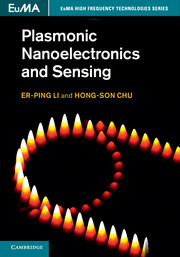Book contents
- Frontmatter
- Contents
- List of contributors
- Preface
- 1 Fundamentals of plasmonics
- 2 Plasmonic properties of metal nanostructures
- 3 Frequency-domain methods for modeling plasmonics
- 4 Time-domain simulation for plasmonic devices
- 5 Passive plasmonic waveguide-based devices
- 6 Silicon-based active plasmonic devices for on-chip integration
- 7 Plasmonic biosensing devices and systems
- Index
- References
3 - Frequency-domain methods for modeling plasmonics
Published online by Cambridge University Press: 05 March 2014
- Frontmatter
- Contents
- List of contributors
- Preface
- 1 Fundamentals of plasmonics
- 2 Plasmonic properties of metal nanostructures
- 3 Frequency-domain methods for modeling plasmonics
- 4 Time-domain simulation for plasmonic devices
- 5 Passive plasmonic waveguide-based devices
- 6 Silicon-based active plasmonic devices for on-chip integration
- 7 Plasmonic biosensing devices and systems
- Index
- References
Summary
Introduction
The rapid development of research on plasmonics in recent years has led to numerous interesting applications, and many plasmonic nanostructures have been designed and fabricated to achieve novel functionalities and/or better performance. For example, optical antennas are used for biochemical sensing [1–4], plasmonic waveguides have been proposed for on-chip optical communications [5], and metamaterials are under consideration for subwavelength imaging [6]. Most of those plasmonic nanostructures are complicated, so we cannot find analytical solutions for them. Therefore numerical modeling methods are the only choice when it comes to device modeling and structural design. Many numerical methods for solving Maxwell's equations have been established. They can be generally categorized into two classes: frequency-domain methods and time-domain methods.
In frequency-domain methods we assume that the electromagnetic wave is a single-frequency harmonic wave with a time dependence term eiωt or e−iωt (most electrical engineers use eiωt, while e−iωtis more popular among physicists. They are essentially the same, except that, when a medium is lossy, the imaginary parts of its refractive index and permittivity take positive values for e−iωt and negative values for eiωt). Then the time dependence in Maxwell's equations can easily be eliminated and the fields are functions solely of space coordinates. The solutions obtained from frequency-domain methods are generally steady-state solutions. There are many frequency-domain methods available for plasmonic device modeling, among which the finite-element method (FEM) and the method of moments (MoM) are very popular.
- Type
- Chapter
- Information
- Plasmonic Nanoelectronics and Sensing , pp. 67 - 98Publisher: Cambridge University PressPrint publication year: 2014



